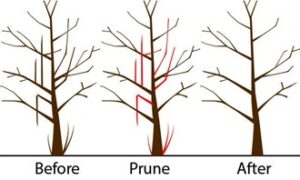General Care:
- Mulch to conserve moisture and reduce weeds.
- Water 1 inch per week from spring until after harvest.
- Roses are heavy feeders.
- Spring: Fertilize with a slow release, balanced fertilizer.
- Throughout season: Feed every 4 weeks.
- Late summer, early fall: Stop fertilizing 6 – 8 weeks before frost date in preparation for winter.
- NOTE: Very sharp thorns. Wear gloves when handling.
Pests & Diseases:
- Susceptible to rose borers, powdery mildew, and fungus.
Late Winter/Early Spring Pruning Steps (start of new growth):
- Remove all remaining leaves.
- Prune dead wood back to the base.
- Prune out crossing branches. Ideally create an open vase-like shape to increase air circulation.
- Remove thin and weak growth (anything thinner than a pencil).
- Shape the remaining canes into desired shape by cutting ¼” – ½” above an outward facing bud, at an angle sloping away from the bud.
- Dispose of any leaves and waste to prevent spread of disease.
Fall Pruning (after killing frost):
- Prune only as needed for winter preparation.
- Trim longer stems to keep from snapping in winter storms.
- Trim crossed branches to prevent rubbing.
- Remove dead/diseased branches and foliage.










